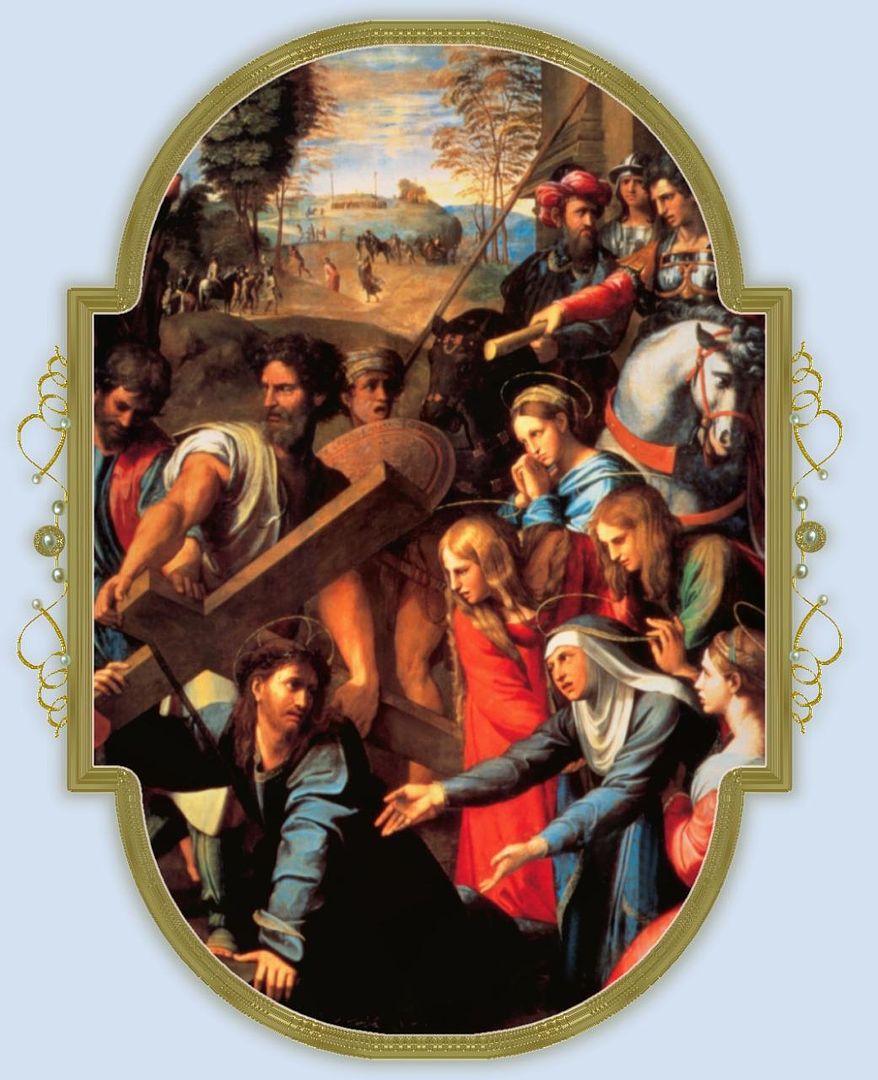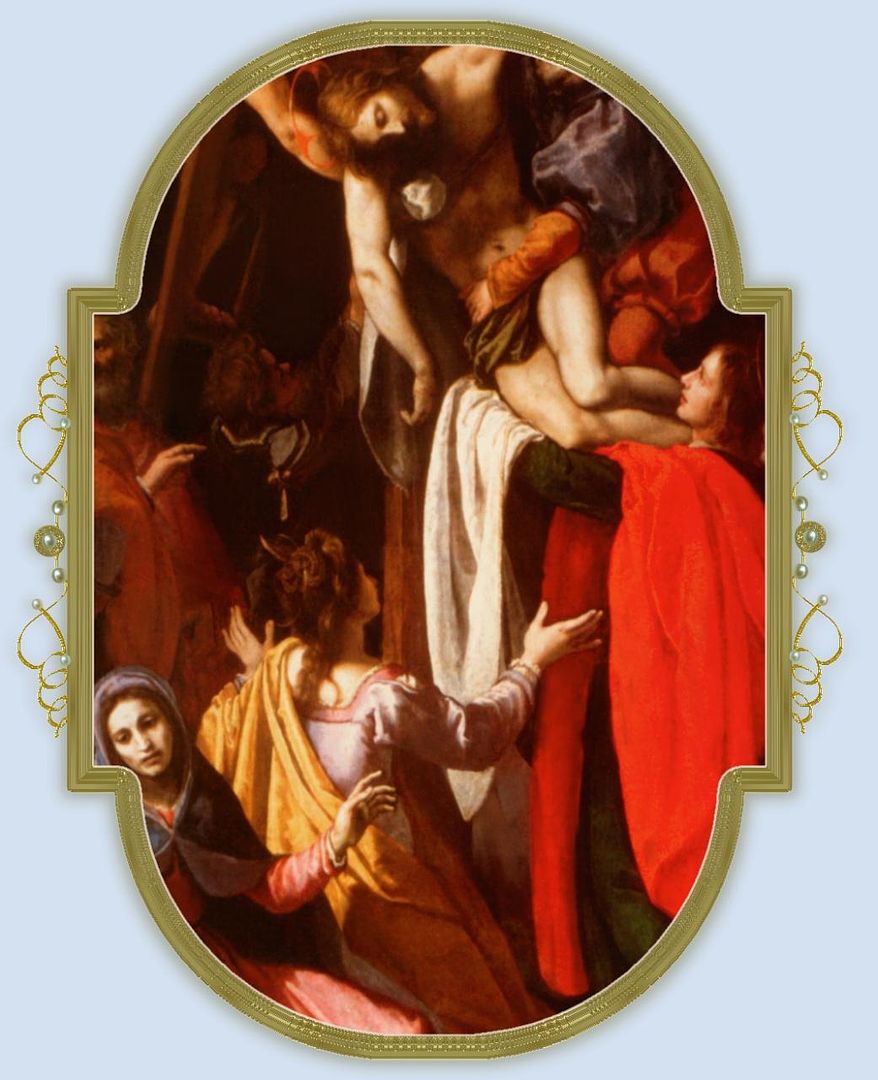Today, September 15, we celebrate the feast of Our Lady of Sorrows. In our communion with Mary, Our Blessed Mother, we recognize that we rarely experience joy without first enduring adversity. We ask Mary, who experienced great sorrow in her own life, to pray for us, so that, in the midst of our trials and tribulations, we may look forward to the joy that comes from remaining faithful witnesses to Christ.
The Seven Dolors (or Sorrows) of Mary are taken from Scripture. Below, a brief meditation on each of the sorrows of Our Blessed Mother.
First Sorrow
The Prophecy of Simeon
Sorrow as sharp as a sword shall pierce Mary's heart because of her Child. Mary is in the Temple, having come with Joseph to present the Child to God. They meet Simeon, the holy man, and Anna, the prophetess. Simeon takes the Baby in his arms, saying he will now die in peace because he has seen Christ, then he foretells the sorrow to come.
The Blessed Virgin Mary gave God her first born as the law prescribed, and Simeon, led by the Holy Spirit, predicted how a sword of sorrow would pierce her heart. The Blessed Virgin knew that she had given birth to the Savior. She immediately and clearly understood this. Though her heart was deeply touched by this favor, her heart remained heavy and troubled for she knew what was written about the suffering and the death of the Savior. Whenever she saw Jesus, she was constantly reminded of His suffering.
Second Sorrow
The Flight into Egypt
Soon the sword of sorrow strikes. Herod the King seeks to kill the Child. Warned in sleep by an angel, Joseph takes Jesus and His Mother Mary, setting out for Egypt, where they lived in obscurity and poverty until it was safe to return to Nazareth.
Mary was greatly troubled when Joseph revealed to her the words of the angel, that they should wake up quickly and flee because Herod wanted to kill the Infant Jesus. The Blessed Virgin Mary hardly had time to decide what to take or leave behind. She took the child Jesus, left everything, rushed outside before Joseph so that they could hurry as God wished. Then she said: "Even though God has power over everything, He wants us to flee with Jesus His Son. God will show us the way and we shall arrive without being caught by the enemy." Because the Blessed Virgin was the Mother of Jesus, she loved Him more than any one else. Her heart was deeply troubled at the sight of the discomfort her Infant Son experienced. Jesus was cold and shivering, and though they were tired, sleepy and hungry during this long travel, her only thought was about the safety and comfort of her Son. She feared coming face to face with the soldiers who had been ordered to kill Jesus, because she was aware that the enemy was still in Bethlehem. Her heart remained constantly anguished during this flight. She also knew that where they were going, there would be no friendly face to greet them.
Third Sorrow
The Loss of Jesus in the Temple
When Jesus is twelve, He is taken to Jerusalem for the Feast of Passover. On the return journey Joseph and Mary find at the end of the first day that Jesus is not with them. Racked with anxiety, they search for Him. Nobody in the streets, not even the beggars, can tell them where He is. Not till the third day do they find Him, in the Temple.
The Blessed Virgin knew God's glory. She, who was most blessed among all others, received the gift of exceptional love, that is the grace to love her Son far more than most parents love their children. Jesus was the only begotten Son of God, and also the Virgin Mary's Son. The Blessed Virgin loved Jesus more than herself, because He was her God. Compared to other children, He was a most unique child because He was already living as God. When Mary lost Him on their way back from Jerusalem, the world became so big and lonely that she believed that she couldn't go on living without her Son Jesus, so great was her sorrow. Jesus had pleased her in everything. He never annoyed her in any way, nor would He ever displease His parents. As she looked anxiously for her beloved Jesus, deep pain welled in her heart; she blamed herself, asking why she didn't take greater care of Him. But it was not her fault. Jesus no longer needed her protection as before. What pained Mary was that Jesus had decided to stay behind without her consent. She knew, however, that her Son always did what was necessary and she never suspected Him of being disobedient. Mary felt the same pain Jesus felt when He was abandoned by His apostles during His Passion.
Fourth Sorrow
Mary Meets Jesus on the Way to Calvary
Mary has known fear and sorrow, but none so great as seeing her beloved Son stumbling under the weight of the Cross. She hears the jeering shouts from the crowd and has no power to help Him. Pity and love are in her eyes as she gazes at His blood-stained face. To many around her He is no better than a criminal, and her heart is breaking as she follows Him to Calvary or Golgotha.
The Blessed Virgin meets Jesus carrying the cross on which He is to be crucified. See the anguish on her face. John is informing her that Jesus, her beloved Son is going to be hanged on Calvary. Mary sees Jesus carrying the heavy Cross alone - the Cross on which He is to be crucified. This doesn't surprise the Blessed Virgin, because she already knew about the approaching death of Our Lord Jesus. Already weakened by the numerous hard blows given with the soldier's clubs, His body resembles a corpse carrying the Cross. Simon was made to help Him. The soldiers kept hurrying and pushing Him. Then He falls once more, exhausted, unable to raise Himself. At that moment, Mary's eyes full of tender love and compassion meet His. Their hearts seem to be sharing the load. Nothing can be done except to believe and trust in God, and dedicate that suffering to Him.
Fifth Sorrow
Mary Stands at the Foot of the Cross
With John, Mary stands at the foot of the Cross. "A sword shall pierce thy soul," Simeon told her. Truly her heart is pierced with sorrow. Her beloved Son is dying and she shares in His suffering. She does not ask God to take away this agony. She is His Mother, so close to Him that His pain is hers, too. And now He speaks from the Cross: "Woman, behold thy son." Jesus give His Mother to John, and to us. For all eternity she is our Mother.
The Blessed Virgin Mary met Jesus and continued to climb the mount, following behind Him painfully and sorrowfully with deep anguish, suffering silently. She could see Him staggering and falling with the Cross. She witnessed His being beaten and His hair pulled to force Him to stand up. Upon arrival to Calvary, He was ordered to confess in front of the crowd so that the crowd would laugh at Him. Mary, like Jesus, deeply felt this pain. The Blessed Virgin felt sick at heart at seeing these tyrants crucifying Him naked and so, shaming Him. Jesus and Mary felt more disgraced than we do because they are holy. The Blessed Virgin Mary felt pain beyond bearing when Jesus lay down on the Cross. His murderers, singing, approached Him with hammers and nails, sat on Him, so He would not shake. As they hammered the nails on both hands, Mary felt the blows in her heart. She felt her life fading away. As they proceeded to put the Cross in the hole ready to receive it, they jerked it, and because of its weight, the pain seared all over Jesus' body. He suffered three excruciating hours transfixed to the Cross. He was hurt to the core at seeing His Mother suffering, too. Then Jesus died with His Blessed Mother called to die with Him in spirit. When His sacred body was taken down from the Cross, it was placed in the arms of His suffering and sorrowing Mother.
Sixth Sorrow
Mary Receives the Dead Body of Jesus in Her Arms
It is over. Dark clouds have appeared in the sky and upon the world. Jesus is dead. Joseph of Arimathea and Nicodemus take down the Body from the Cross. and Mary receives It in her arms. She is filled with a sadness that no human heart has known. This is her Son. Once she had cradled Him in her arms. listened to His voice, watched Him working at the carpenter's bench. Now He is dead. She does not weep, her grief is too great for tears.
The friends of Jesus, Joseph and Nicodemus, took down the body of Jesus from the Cross and placed it in the arms of the Blessed Virgin. Then, Mary washed it with deep respect and love because she was His Mother. She knew better than anyone else that He was God who made Himself the Savior of the people. She could see terrifying wounds because of the flogging He received at the hands of Pilate. His flesh had been torn in strips with pieces removed. All over His body there were gaping wounds. Mary found that the scars and wounds from the nails were less severe than those caused by the flogging and by the carrying of the Cross. His beloved Mother was horrified at the thought that He managed to carry the Cross. She saw that all the wounds on His Head had penetrated to the brain. She found that Jesus’ death was far worse than that of the bandits. When she saw Him, she remembered all about Him, from His infancy up to that time, and it filled her with deep anguish and sorrow. Our Blessed Mother continued to be a martyr. She, the Queen of Martyrs, didn't hesitate to give her Son who became the Savior of all humanity. She prayed that everybody would go to Heaven; that all would truly follow God, so that Jesus’ torturous death would not be in vain. The Blessed Virgin Mary prayed for us all.
Seventh Sorrow
Jesus is Placed in the Tomb
Hastily the Body is wrapped in a clean linen cloth. Nicodemus has brought myrrh and aloes, and the Body is bound in the Shroud with them. nearby is a new tomb, belonging to Joseph of Arimathea, and there they lay Jesus. Mary and John and the holy women follow them and watch as the great stone to the sepulchre is rolled. it is the end.
The life of the Blessed Virgin Mary was closely linked to that of Jesus and depended on Him. As for her, she wanted Him to die so that all His unspeakable suffering would come to and end. Our sorrowful Mother, with the help of John and the holy women, devoutly placed Him in the sepulchre. Then she went home with great pain, dying at heart with her Son Jesus but with the ardent hope He would resurrect without delay. For the first time she remained without Him.
Why pray the Rosary every day for a year?
Each time the Blessed Virgin has appeared-- whether it be to Saint Bernadette Soubirous at Lourdes; to Lucia, Jacinta, and Francisco at Fatima; or to Mariette Beco at Banneux-- she has asserted the importance, saving grace, and power of praying the Holy Rosary on a daily basis. Based upon her words, the Rosary is penance and conversion for sinners, a pathway to peace, an end to war, and a powerful act of faith in Jesus Christ. Pope Paul VI presented the Rosary as a powerful means to reach Christ "not merely with Mary but indeed, insofar as this is possible to us, in the same way as Mary, who is certainly the one who thought about Him more than anyone else has ever done."
To show us how this is done, perhaps no one has been more eloquent than the great Cardinal Newman, who wrote: "The great power of the Rosary consists in the fact that it translates the Creed into Prayer. Of course, the Creed is already in a certain sense a prayer and a great act of homage towards God, but the Rosary brings us to meditate again on the great truth of His life and death, and brings this truth close to our hearts. Even Christians, although they know God, usually fear rather than love Him. The strength of the Rosary lies in the particular manner in which it considers these mysteries, since all our thinking about Christ is intertwined with the thought of His Mother, in the relations between Mother and Son; the Holy Family is presented to us, the home in which God lived His infinite love."
As Mary said at Fatima, "Jesus wants to use you to make Me known and loved. He wishes to establish the devotion to My Immaculate Heart throughout the world. I promise salvation to whoever embraces it; these souls will be dear to God, like flowers put by Me to adorn his throne."

Subscribe to:
Post Comments (Atom)














0 comments:
Post a Comment
Thanks for leaving a comment. If you wish to submit a prayer request, however, please do so above, using the "Contact" tab.